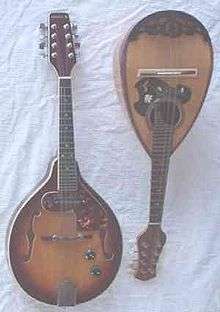Electric mandolin

The electric mandolin is an instrument tuned and played as the mandolin and amplified in similar fashion to an electric guitar. As with electric guitars, electric mandolins take many forms:
- Most common is a carved-top eight-string instrument fitted with an electric pickup in similar fashion to many arch top guitars.
- Solid body mandolins are common in 4-, 5-, and 8-string forms.
- Acoustic electric and semi-acoustic mandolins also exist in many forms.
History
Electric mandolins were built in the United States as early as the late 1920s. Among the first companies to produce them were Stromberg-Voisinet, Electro (which later became Rickenbacker), Vivi-Tone, and National Reso-Phonic. Gibson and Vega introduced their electric mandolins in 1936.
In the United States, luthier/inventor Paul Bigsby began building solidbody electric mandolins (technically, they consisted of a solid wood core housing the electronics, with hollow wings forming the body) in 1949. His first one had 10 strings and was built for Al Giddings. Other Bigsby electric mandolin players were multi-instrumentalist Paul Buskirk, Johnny Muessig, and Eschol Cosby. Bigsby's most famous mandolin, built in 1952, was owned and played by Western swing musician Tiny Moore. This instrument had 5 single courses rather than the more common four double courses, and was patterned after a similar instrument built by Jim Harvey of La Jolla, California, for a player named Scotty Broyles. Gibson and Rickenbacker introduced solidbody 8-string mandolins in the 1950s,[1] while Fender followed the single-course idea with its 4-string version.
A related instrument, the Bahian guitar, was developed in Brazil beginning in the 1940s. Bahian guitars typically have a solid body and 4 or 5 single-course strings tuned in fifths, but are considered to be electric versions of the cavaquinho rather than the mandolin.
Solid Body Electric Mandolins
Both four string single course and eight string double course solid body mandolins have been produced by several makers, as well as five string single course models.
From 1956 to 1976, Fender produced a four string version which they simply called the Fender Electric Mandolin. Its body shape was based on a smaller version of the Stratocaster body. They currently produce an eight string semi-acoustic electric mandolin with a very similar body shape. They also currently produce a revived version of the Fender Electric Mandolin concept, called Mando-Strat; both the 4-string replica and an 8-string version are available.

Gibson manufactured the EM-200 solid body electric mandolin from 1954 to 1971. They currently produce a solid body mandolin known as the Mandobird, based on a smaller version of the Gibson Firebird body and sold under the Epiphone label. Both four and eight string versions are available.
The Mid-Missouri Mandolin Company produced two models, the EM-4 and EM-8, with carved top bodies and four and eight strings respectively. Blue Star produces four and five string models under the name Mandoblaster. Jbovier produces four and five string "EMC" electric mandolins, which resemble the Fender electric mandolins, and a four string "ELS" electric mandolin. EMC stands for Electric Mandocaster and ELS stands for Electric Leo Smith.
The Eastwood Guitars manufactures solid body eight string electric mandolin under the name Mandocaster. It has Telecaster resembling body, two single coil pickups and a pickup switch known from Stratocaster guitars. They also make Mandocaster 12 which is actually an octave guitar. It is tuned the same as any standard guitar, E-E, but an octave higher.
 Fender Electric Mandolin profile
Fender Electric Mandolin profile
Players
While the electric mandolin has increased in popularity along with its acoustic cousin, there are still relatively few recordings featuring it as a lead instrument on more than a song or two. The following artists have issued full-length recordings prominently featuring an electric mandolin throughout:
- Tiny Moore (Western swing)
- Yank Rachell (blues)[2]
- John Kruth (eclectic instrumental folk/rock/jazz)
- Mark Heard (singer-songwriter/Americana)
- Michael Kang/String Cheese Incident (jam band)
- Uppalapu Srinivas (South Indian Classical)
- Warren Ellis (alternative rock/folk)
- Nash the Slash (rock/electronica)
- Ben Mink (rock/pop)
- Charles O'Connor of Horslips (celtic rock)
References
- ↑ Rickenbacker 5002V58
- ↑ "Blues mandolin man: the life and music of Yank Rachell" by Richard Congress year=2001 |publisher=University Press Mississippi |language=English |isbn= ISBN 1578063345 | ISBN 978-1578063345 |pages=80-81 |chapter=21 |quote="When electric come in, that was something new to me, so I played that. I plugged my mandolin up into it. It sound good, so I went to playing electric all the time, you know"
External links
- Emando.com
- Mandobird 4 at the Epiphone website.
- Fender Electric Mandolin collector's site.
- Mando-Strat at the Fender website.
- Mandocaster at the Eastwood Guitars website.